Planned Costs
The Planned Costs page allows you to enter all expenses and all team Human resources you expect the folio will require during its lifespan.
Expenses are added to one of three main categories: Operational expenditures (OPEX), Capital expenditures (CAPEX) or Financial expenditures (FINEX). Expenses can be single occurrence or recurrent ones. Human resources are the staff members you will need to accomplish the work, such as developers, testers, team leads, etc. and are added to the operational expenditures. Information entered here will be used to provide project health metrics on the Overview page and shown as a reference on the Costs Forecast chart.
Planned costs can be baselined for future reference and comparing various scenarios.
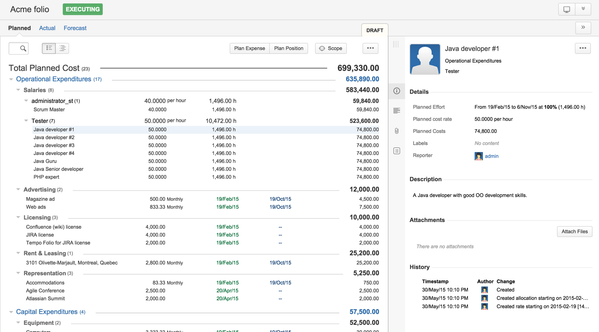
Expenses
Expenses are all the expenses you plan for the folio to incur at one point or another. The Planned Costs page shows the calculated cost for each expense and expense group (type). You can collapse or expand a group of expenses by clicking the triangle icon (
 ) next to the expense type.
) next to the expense type.
See the Expenses page for more information on expenses and how their cost is calculated.
Planning an expense
To add an expense, either click the Plan Expense button or hit the "a" (for add) shortcut key. This displays the expense editing dialog. Refer to the Editing an Expense section to learn how to fill out the editing dialog. Select the Plan another check box at the bottom of the dialog in order to create many expenses, one after the other.
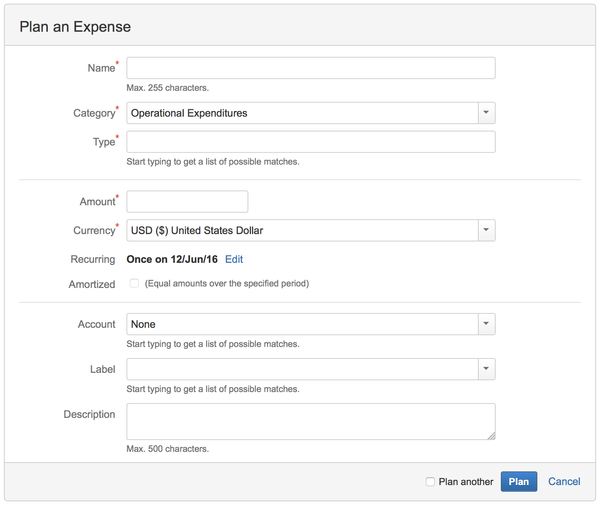
Name | Name of the expense. Examples: Rent for 222 Main Street, IDE licenses, Printer toner, Web hosting fee |
|---|---|
Category | Category of the expense. See the section Categories for more details on each option. |
Type | Type of the expense. This is used to classify expenses and for filtering in reports. When you type in this field, expense types entered previously that match what you type will be suggested to you for completion to help you avoid typos and duplication. Examples: Rent, Office furniture, Licenses, etc. |
| Amount | Amount of this expense. Note that in the case of a recurrent expense, the amount of the payments for that expense will depend on whether it is amortized or not. In the case of an amortized expense, the amount entered here will be evenly split into the number of payments defined in the recurrence definition. Otherwise, the amount of each payment is the amount entered in this field. |
| Currency | The currency of the expense. Default: Currency of the folio |
Recurring | By default, an expense occurs on a single date. To change the date of occurrence of that expense or to make the expense recurrent (and possibly amortized), click the Edit link. This brings up a dialog allowing you to define the recurrence settings for that expense. As you change the values in that dialog, you are presented with a description of the recurrence, in the text area located just above. Refer to Recurrence for more details. |
| Amortized | Specifies whether the payments for that expense should be split over a period of time. This option appears under the Recurring field when the Repeat value in the Recurrence definition dialog is changed to something other than Once. When amortized, this expense is evenly split into payments occurring on dates defined in the Recurring field. |
| Account | Specifies the Tempo Account to associate the expense with. (optional) |
| Labels | JIRA Issue Labels to associate the expense with. Refer to Labels for more details. |
| Description | An optional, free-form description of the Human resource human resouce. |
Copying an expense to actual costs
Select an existing expense to copy to actual costs by clicking on it and then either clicking on the drop-down menu in the top-right part of the expense details view (on the right side of the screen) and selecting the Copy to actual option, or hitting the "V" shortcut key. This will copy the selected expense to actual costs, including its attached files.
You can copy multiple expenses to actual costs in one go by selecting them in the budget (press and hold down the Control key while you click the expenses to be copied). You can then copy the selected expenses in the same way you copy a single expense. The confirmation message will inform you of the number of expenses that have been copied.
Human Resources
Human resources are the salary expenses you plan for the folio to incur at one point or another. The planned costs page shows the calculated cost for each Human resource and Human resource group (title). The cost displayed on group title rows is simply the sum of the costs of the Human resources in that group. You can collapse or expand a group of Human resources by clicking the triangle icon (
 ) next to a Human resource title.
) next to a Human resource title.
See the Human resources page for more information on Human resources and how their cost is calculated.
Planning a Human resource
To plan a Human resource, either click the Add Human resource button or hit the "o" (for Human resource) shortcut key. This brings up a human resource editing dialog. Check the Plan another box at the bottom of the dialog in order to create many Human resources, one after the other.
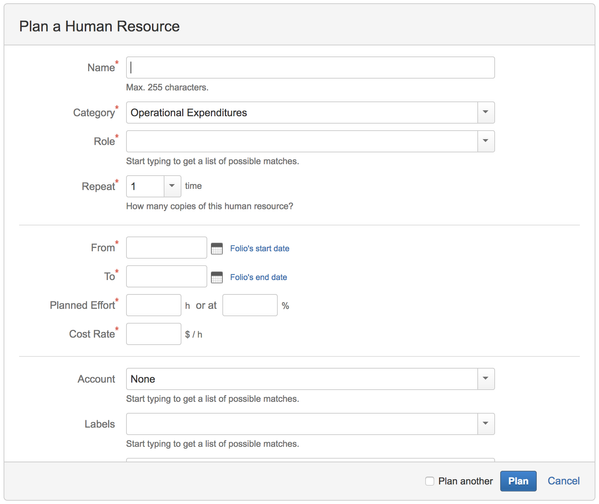
Name | Name of the Human resource Examples: J2EE Developer 1, Database Administrator |
|---|---|
Role | Role of the resource used to classify Human resources. The list of valid roles is configured by JIRA administrators at the add-on level under Tempo Teams > Team Roles. Examples: Developer, Q&A, Management, etc. |
Cost rate | Hourly rate for this Human resource (wage). |
| Repeat | Number of Human resources to create. Example: if repeat is 6, Tempo Budgets will create six Human resources. All created Human resources will have the same values (title, wage, ...). |
| From | Date on which work on the project is planned to start for the Human resource or Human resources. |
| To | Date on which work on the project is planned to end for the Human resource or Human resources. |
Planned Effort | Amount of time the Human resource is planned to be active during the folio. The effort can be entered in one of two ways:
The effort will be displayed as a number of hours in the Planned costs screen, no matter how the value was entered. |
| Account | Specifies the Tempo Account to associate the Human resource with. (optional) |
| Labels | JIRA Issue Label to associate with the Human resource. Refer to Labels documentation for more details. |
Description | An optional, free-form description of the Human resource. |
Planning Human resources from estimates
Tempo Budgets can automatically plan Human resources based on the estimated effort of issues within the folio's scope and time frame.
- Derives planned Human resources to match the sum of original estimates of the folio's scope.
- Completes budgeted Human resources if your currently planned Human resources are not sufficient to match the estimated effort
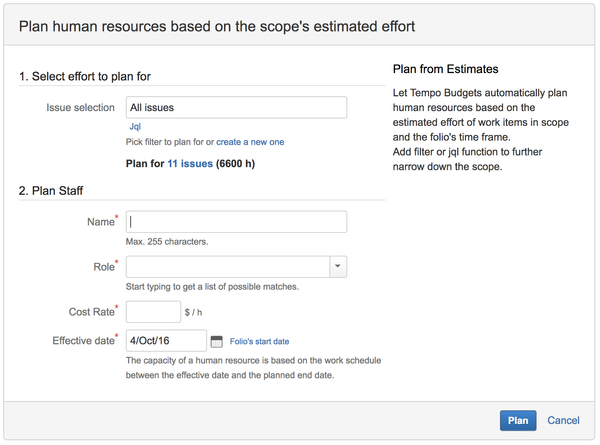
Name | Name of the Human resources Examples: J2EE Developer 1, Database Administrator |
|---|---|
Role | Role of the resource used to classify Human resources. The list of valid roles is configured by JIRA administrators at the add-on level under Tempo Teams > Team Roles. Examples: Developer, Q&A, Management, etc. |
Cost rate | Average hourly rate for these Human resources (wage) |
Effective date | The capacity of a Human resource is based on the work schedule between the effective date and the folio's end date. |
Planning Human resources from staff members
Tempo Budgets can automatically plan Human resources based on staff members' cost rates and availability, assigned issues, or planned items. It will populate the planned costs with Human resources matching the current structure of the folio's staff. All derived Human resources will inherit the availability and cost rates of the source staff member. See all options in Plan from Staff Members.
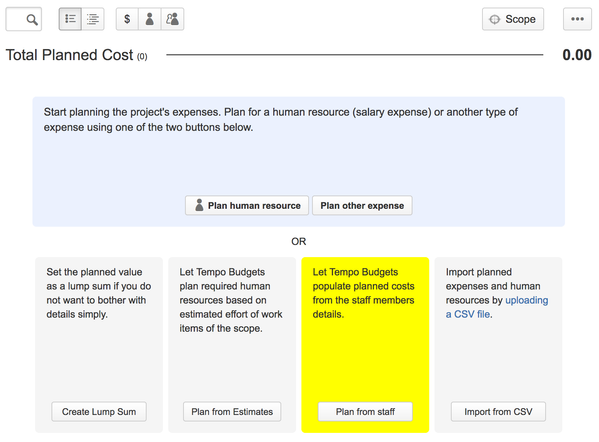
Editing a Human resource
Select an existing Human resource to be modified by clicking on it and then either clicking on the ... menu in the top-right part of the details panel (on the right side of the screen) and selecting the Edit option, or hitting the e (for edit) shortcut key. This brings up the editing dialog. Refer to the Adding a Human resource section for a detailed description of the editing dialog.
Deleting a Human resource
Select an existing Human resource to be deleted by clicking on it and then either clicking on the ... menu in the top-right part of the details panel (on the right side of the screen) and selecting the Delete option, or hitting the d (for delete) shortcut key. This brings up a dialog to confirm the deletion. Click the Delete button to confirm the deletion, or Cancel to cancel. Deletion is permanent, so make sure you really want to delete a Human resource before proceeding.
You can delete multiple Human resources (and even a mix of expenses and Human resources) in one go. Refer to Multiple Selection to learn how to perform bulk deletion.
Expenses and Human resources Timeline
The Timeline view is displayed when the right part of the toggle button located in the top-left corner of the Expenditure Browser is pressed  . It shows each expense payment and planned Human resources over the Folio's time frame as an interactive timeline chart. Each element displayed for an expense (shown in blue) on the timeline reflects a payment for that expense. Human resources (shown in green) are show as periods, covering the planned availability period for each planned Human resource.
. It shows each expense payment and planned Human resources over the Folio's time frame as an interactive timeline chart. Each element displayed for an expense (shown in blue) on the timeline reflects a payment for that expense. Human resources (shown in green) are show as periods, covering the planned availability period for each planned Human resource.
Timeline charts in Tempo Budgets offer various controls to navigate and focus on certain periods of time. Please refer to the Timelines page to learn more on available ways to interact with the Timeline.
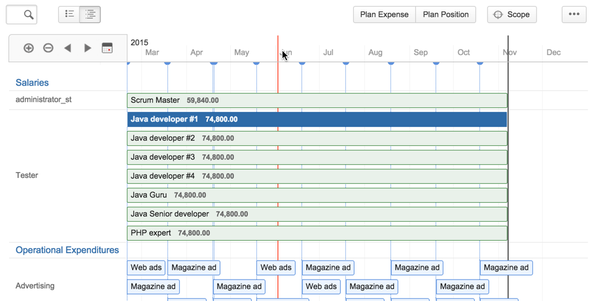
All operations described above can be executed directly from the timeline, including editing, deletion, search, multi-selection, etc.
Hovering over one of the timeline elements shows the date or time period corresponding to that element and its summary information, such as its name and planned cost.
Import / Export
Tempo Budgets Allows you to import or export your data in CSV (comma separated values) format.
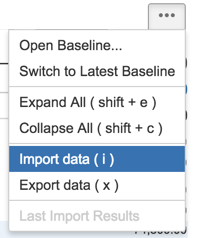
Importing Planned Costs
To import data from an existing CSV file, click on the ... button, and select Import data. Alternatively, you can type the keyboard shortcut i to open the import dialog. See Importing Data from CSV and Planned Costs/Revenues Import to learn more about importing Planned Costs.
Exporting Planned Costs
To export data to an external CSV file click on the ... button, and select Export data. Alternatively, you can type the keyboard shortcut x to instantly export data. The exported CSV file includes both planned Human resources and expenses. See Planned Costs or Revenues CSV Export Detail to learn more about export data.
Approving planned costs
Planned costs can be approved using a baselining mechanism. Refer to the Baselines page for more information on managing baselines.
Scope Inspector
The scope inspector allows you to view the breakdown of the folio's scope by issue type (user stories, bugs, etc.) and see whether the planned Human resources have a capacity that matches the effort required for that scope. It will help you answer questions such as:
- Are the planned salaries sufficient to implement the planned features of our application?
- How much required effort has been estimated for the planned scope? How much to fix the known bugs?
- What's the maximum effort a person can possibly provide given the current folio's time frame?
Clicking the Scope button brings up that information in the details panel on the right.
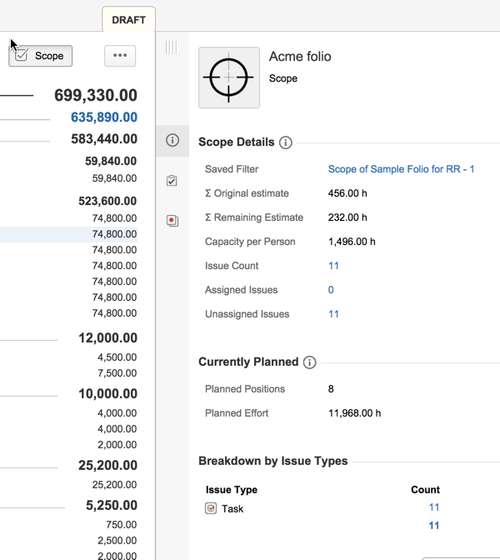
| Details | |
|---|---|
Shows or hides Scope Inspector. | |
| X | Hides the Scope Inspector. |
 | Inline Help. Clicking on the icon opens up an inline dialog containing definitions of elements displayed in the section. |
| Saved filter | Clicking on Saved Filter displays all JIRA issues included in your folio's scope |
| Capacity per Person | A single person's capacity in terms of regular working hours, given the folio's time frame and the Working Schedule configuration. |
| Planned Human resources | Total number of Human resources currently planned |
| Planned Effort | Total number of working hours currently planned |
| Assigned Issues | Number of assigned issues among all issues in this folio's scope. |
| Unassigned Issues | Number of issues that are not assigned among all issue in this folio's scope. |
| Currently Planned | |
| Planned Human resources | Number of planned Human resources in this folio. |
| Planned Effort | Number of work hours planned in this folio. |
| Breakdown By Issue Type | |
| Issue Type | Type of issues (User Story, Task, Bug, etc.) |
| Count | Total number of issues by type |
| Earned Value Field | Sum of the Earned Value Field for all issues of a given type. Will not be display if Earned Value Field is set to Original Estimate. |
| Original Estimate | Sum of Original Estimate for all issues of a given type. |
Good reads:
Tempo for Server Documentation
For the newest versions of Tempo documentation, please visit our Help Center. For support, see our Support Portal.